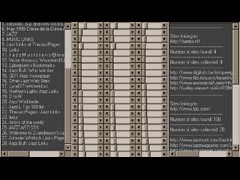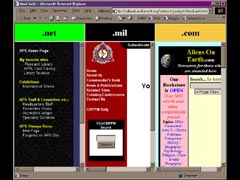| http://netomat.net/l |
 |
|||
|
In which circumstances or on what occasion did you introduce [electricity or electronics] TELEMATICS or THE NETWORK into your work? I first began exploring telematic technologies in the mid-1990s because I was fascinated with the development of networks and the way by which individuals and groups were interacting with these dynamically evolving structures. These explorations manifested themselves in three projects, the "Inter-Sections Project," F"etch-a-Sketch" and "Tele-Touch." The "Inter-Sections Project" was initiated in 1995 in collaboration with Total New York, äda-web, and the Postmasters Gallery. The project involved outfitting a New York City taxi cab with a global positioning satellite receiver and a digital camera. This enabled visitors to the "Inter-Sections" website to both locate the position of the taxi and take candid, real-time snapshopts of the taxi's occupants. "Inter-Sections" explored issues of privacy, mobility and technological voyeurism in a game-like context. Due to lack of funding, the project was never shown. During this period, I also began working on two other projects, "Fetch-a-Sketch" and "Tele-Touch." With "Fetch-a-Sketch," I created a larger than life replica of an etch-a-sketch which functioned as a unique interface to the Internet--allowing visitors in the physical space to create drawings and upload them to the Internet while simultaneously allowing users on the "Fetch-a-Sketch" website to create and send drawings to those in the physical space. "Tele-Touch" explored the notion of human touch and telepresence in a computer-networked environment. The show involved creating a jacket equipped with wireless touch output devices that allowed a person who is wearing the jacket to be touched by visitors to the "Tele-Touch" website. How can you describe the technical and aesthetical part played by [elecricity] TELEMATICS in the work you will be showing in the [Electra] TELEMATIC CONNECTIONS exhibition? Please give your comments as regards these points. The "netomatheque" project uses telecommunication and network technology to enable visitors to converse freely with the network using their own voice. The "netomat" technology employs a voice-recognition and text-to-speech engine as well as search and rendering engine. The voice-recognition engine translates the visitors voice input into search queries which then locate the relevant resources on the network (e.g. images, sound, text). Each of these resources is a decontextualized fragment of data which has been removed from its original context (e.g. a webpage or a database) and recontextualized within a new virtual, public network, which sits on top of the existing physical network. Once the virtual network has been built it evolves in real time based on continuing user input. The rendering engine processes the relevant resources enabling them to be projected in a dynamic, streaming display. The "netomatheque" aesthetic is similar to that of long-term memory, in that it involves associative semantics, where voice inputs trigger constantly evolving streams of information representing the network's memory. According to you, which are the consequences that can arise from the combination of art and contempoary TELEMATIC technology? Telematic technology is a tool by which something can be accomplished, conveyed, or transferred. Used as an artistic technique, it can become a means of expression. The consequences of using and developing telematic technologies for art are dialectic in its nature. There is always a tension between advances in telematic technologies and the subsequent consequences of these advances. For example, the "netomat" technology is currently being developed as a means for individuals and businesses to create their own virtual public networks to communicate and express themselves. This deployment will undoubtedly raise many interesting issues about privacy, accessibility, control, and ownership. *These questions are based on ones asked by Frank Popper of the artists in his seminal exhibition Electra: Electricity and Electronics in the Art of the 20th Century in 1983 at the Musée d'Art Moderne de la Ville Paris |

